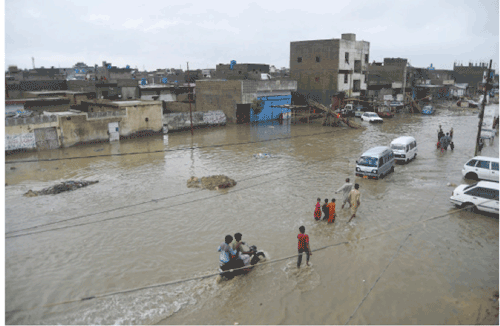Drained!
By Farhan Anwar | Newsline Special | Published 6 years ago
The recent rains in Karachi have yet again exposed the critical fault lines within the key urban infrastructure and services sectors of the city. Drains and sewers overflowing, bringing tons of openly and randomly dumped garbage on the streets. Roads cracking up, prolonged power failures and water supply shortages. These were just the more obvious of the manifestations of an urban governance construct that is severely fragmented and becoming increasingly incapable of meeting the challenges of urban growth in the city.

Commuters cross a flooded street during heavy monsoon rains in Lahore on July 30, 2019.
Water and sewerage services in the city are critically challenged. In order to better understand this crisis, it would be instructive to place its physical aspects in a political, policy and institutional context. Quite often, the monopoly service provider – the Karachi Water & Sewerage Board (KW&SB), prioritises the crisis within a simple supply and demand equation, implying that increased provision of water for the city will resolve the crisis. In this regard, the delay in operationalising the K-IV Water Supply project is cited as a fundamental cause of the current water crisis. While Karachi definitely needs to upgrade its water production, this factor is just one among many complicated and interwoven causal factors contributing to the alarming decline in the level and quality of services. Around 650 million gallons per day (MGD) water is produced. As per World Health Organisation (WHO) standard of 55 gallons per capita per day, Karachi’s current water needs are estimated at 1,200 MGD. This translates to a shortfall of more than 550 MGD. As such, a sizable supply and demand gap exists.
However, we need to first look at what happens to the water we are currently producing. What is often not highlighted is that of the 650 MGD produced, even according to the estimates of the KW&SB, 35 per cent (192 MGD) is considered as Non-Revenue Water (NRW), that is a cumulative sum of water either lost to system leakages or stolen, and water supplied against which revenue is not generated. The exact NRW percentage could be much higher in the absence of metering and operating of an intermittent supply network. This NRW figure highlights some critical realities that plague KW&SB. The fact that water is lost indicates severely decayed infrastructure, while water theft can be attibuted to mismanagement and lack of political ring-fencing. Failure to collect thus indicates a collapse in the writ of the institution.
 This is not surprising. KW&SB is far from being an autonomous institution and is rendered vulnerable to political manipulation and control by its inherent governance construct. According to a recent World Bank report, key functions – including approval of budgets, regulations and tariffs, hiring and postings, and provision or facilitation of locally mobilised funds or foreign loans or grants – lie within the purview of the provincial government. Additionally, KW&SB relies directly on subsidies from the provincial government and is fully dependent on provincial and federal funds for debt servicing and infrastructure expansion to meet growing needs and close the service deficit gap. Tariffs are based on plot size and are extremely irrational and inadequate. KW&SB, despite repeated attempts, has not been able to rationalise tariffs owing to lack of political will. This high level of political interference constrains long term and integrated planning, kills professionalism and institutional efficiency and opens the gates for widespread corruption and rent seeking along with operations such as the infamous water tanker service.
This is not surprising. KW&SB is far from being an autonomous institution and is rendered vulnerable to political manipulation and control by its inherent governance construct. According to a recent World Bank report, key functions – including approval of budgets, regulations and tariffs, hiring and postings, and provision or facilitation of locally mobilised funds or foreign loans or grants – lie within the purview of the provincial government. Additionally, KW&SB relies directly on subsidies from the provincial government and is fully dependent on provincial and federal funds for debt servicing and infrastructure expansion to meet growing needs and close the service deficit gap. Tariffs are based on plot size and are extremely irrational and inadequate. KW&SB, despite repeated attempts, has not been able to rationalise tariffs owing to lack of political will. This high level of political interference constrains long term and integrated planning, kills professionalism and institutional efficiency and opens the gates for widespread corruption and rent seeking along with operations such as the infamous water tanker service.
Then, to compound the financial crisis there is a high level of revenue under-collection and distribution losses. Only 30 per cent, or 300,000 out of a total 1.1 million customers, are being billed. On average, KW&SB generates Rs 850 million per month (US$ 8.5 million per month) while it collects Rs 550 million per month (US$ 5.5 million per month), which puts collection efficiency at around 65 per cent, far below the best practice of 100 per cent. Again, because of the political control wielded by various political entities with regular political appointments sans any consideration for merit over the years, KW&SB is heavily overstaffed. It has around 13,500 employees, or 6.5 employees per 1,000 connections, more than thrice the 2.0 employees per 1,000 connections frequently used as the international benchmark for developing countries. Therefore it comes as no surprise that KW&SB is a financially bankrupt organisation, barely able to sustain administrative expenses, what to talk of financing viable day-to-day maintenance or capital investment.
 Sewerage services are in an even worse state. According to World Bank estimates, more than six million Karachiites have no access to public sewerage services. Sewerage network coverage is estimated at 60 per cent and faces complex challenges of inadequate sewer trunk mains, malfunctioning pumping facilities, and insufficient wastewater treatment capacity. The amount of raw sewage discharged into the sea each day is 475 MGD. The sewerage network of the city has had very little maintenance since the 1960s (ADB 2007), and the three existing wastewater treatment plants are dysfunctional. Additionally, separation of municipal wastewater from industrial effluent is not a common practice. Two of the biggest industrial estates in Pakistan, both located in Karachi, have no effluent treatment plant, and the waste –containing hazardous materials, heavy metals, oil, and so on – is discharged into Karachi’s rivers and the already polluted harbour (Worldwide Fund for Nature, 2007).
Sewerage services are in an even worse state. According to World Bank estimates, more than six million Karachiites have no access to public sewerage services. Sewerage network coverage is estimated at 60 per cent and faces complex challenges of inadequate sewer trunk mains, malfunctioning pumping facilities, and insufficient wastewater treatment capacity. The amount of raw sewage discharged into the sea each day is 475 MGD. The sewerage network of the city has had very little maintenance since the 1960s (ADB 2007), and the three existing wastewater treatment plants are dysfunctional. Additionally, separation of municipal wastewater from industrial effluent is not a common practice. Two of the biggest industrial estates in Pakistan, both located in Karachi, have no effluent treatment plant, and the waste –containing hazardous materials, heavy metals, oil, and so on – is discharged into Karachi’s rivers and the already polluted harbour (Worldwide Fund for Nature, 2007).
A neglected aspect of the services is the provision of services to the poor and under-privileged sections of the population. This raises the critical issue of urban inequity that generally defines Karachi’s overall urban governance construct. It is clearly indicated that no institutional mechanism exists within KW&SB to effectively manage the huge challenge of service delivery to the poor. More than 50 per cent of the population resides in unplanned settlements where multiple models of community interface with civic service access are on display. This requires a greater understanding of the ground realities, staff that is specially trained in dealing with communities, understanding and accommodating unconventional systems within the formal infrastructure and generally a large field staff base. Presently, there is no dedicated department or staff looking after the unplanned settlements/katchi abadis. An effort was made in the year 2013 to establish a Katchi Abadi Revenue Generation Cell (KARGC) in the KW&SB. However, the only evidence that such a Cell was established is the notification formalising its establishment. Yet again, this institutional inertia can mostly be attributed to political interference and brings into play the political economy context of the services to the poor challenge. Settlers in the unplanned settlements are considered as pliant vote banks and often are favored in the provision of services in a way that normal procedures and mechanisms of service delivery are bypassed. This has created problems in ensuring quality in service provision and at times even in the effective regularisation of unplanned settlements where many have seen rehabilitation work through MNA/MPA and Councillor funds. In such cases, even prior to regularisation, KW&SB has been asked to provide water connections.

Before fixing the ‘pipes’ what is needed is to fix the ‘institution’ that fixes the pipes! KW&SB has to be made truly autonomous as a priority. This would lead to it becoming a professional and efficient entity, politically ring fenced and driven by a long term vision of sustainable planning and provision of services, requiring adjustments at the policy and institutional level. Subsequently to be considered are innovative management options of outsourcing of services, community engagement and collaboration. Various planning studies have highlighted a number of options to improve efficiency and streamline functions. Unbundling of services, rethinking the present construct of bulk and retail services are considerations that need to be looked into. The institutional mindset needs to change – from a ‘provider’ of services to all, to a ‘guarantor’ that all are provided for.
In terms of core service related measures, system rehabilitation needs to be undertaken to prevent leakage of water. Water metering has to be enforced at the retail/household level to discourage water wastage. Illegal practices such as use of suction pumps/direct drawing of water from main supply lines etc. must be discouraged and penalised, as they result in an inequitable supply of water. A plan has to be enforced to ensure 24/7 water supply within a short time frame. The tariff structure has to be rationalised, coupled with improved services and full recovery of water charges has to be ensured to make operations financially viable. Water conservation practices should be initiated by raising user awareness and rewarding good conservation practices. Then it has to be ensured that land use violations such as illegal increased densification that result in escalation of water demand do not take place. For poor settlements, there needs to be thorough documentation of all informal settlements, disconnection of all unauthorised connections, followed by engineered integration of informal settlements in KW&SB systems. There is also a need to learn from success stories and formalise selected ‘community model coping mechanisms’ in the KW&SB system.


